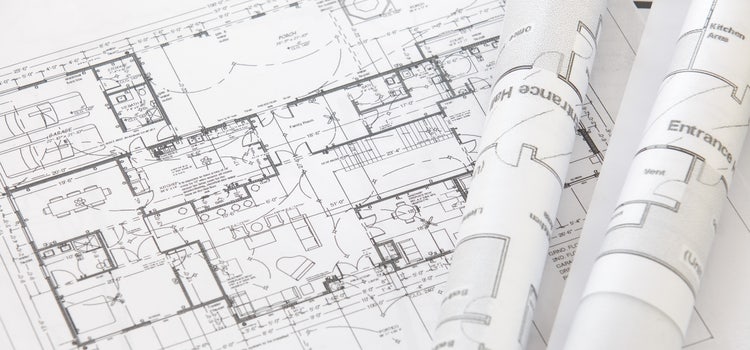Unlocking a world of possibilities with large format printers

Architectural plans, technical project drawings, etc. are printed on large format printers (LFPs), now powered by Adobe Embedded Print Engine/Image Credit: Adobe Stock/torsakarin.
In today's digital age, large format printers (LFPs) have become essential tools for businesses, artists, and professionals, transforming how we create impressive visuals for different purposes. These printers produce high-quality prints on a large scale, allowing professionals to express their creativity and effectively convey their messages.
LFPs serve multiple segments, including signage, advertising, architecture, maps, fine arts, and interior décor. The market for these printers has grown significantly due to the increasing demand for large-scale prints and advancements in inkjet technology are opening up new opportunities. Reports indicate that the global LFP market was valued at around $9 billion in 2022 and is projected to reach $12.6 billion by 2031, with an annual growth rate of 3.5 percent.
Compared to traditional home or office printers that usually handle A4-size paper, printing with an LFP is more complex. LFPs can print on much larger paper sizes, like A0, offering approximately 16 times more surface area for printing. LFPS and grand format printers can be single-pass, multi-pass, flatbed, or roll-fed. These printers excel at handling highly detailed and graphic-rich files such as maps, CAD (Computer Aided Designs) drawings, and architectural plans, requiring powerful processors to render intricate details accurately.
A crucial component of LFPs is the Raster Image Processor (RIP), which translates graphics into raster pixels instructing each inkjet nozzle where to deposit a droplet of ink. The RIP acts as the printer's brain, ensuring the original content is faithfully reproduced on the substrate. Adobe PDF Print Engine is the market leading RIP technology for printing to an LFP device, where rendering takes place on a host system, or as part of a dedicated software workflow solution. However, for a self-contained LFP printer, rendering must take place on-board the device, which requires a more agile technology.
Adobe Embedded Print Engine (AEPE) is Adobe’s RIP technology for printers that contain a built-in RIP. Today, it drives millions of printers, across a wide range of device types. AEPE is the market leader for A3 printing in desktop printers, and A3/A4 printing on enterprise multi-function printers (MFP). Recent AEPE enhancements can help to take maximum advantage of the capabilities of a self-contained LFP printer, with a minimum of complexity.
Spot colors are specific pre-mixed ink colors used directly (rather than mixing CMYK combinations), offering precise color reproduction and adherence to brand guidelines. Organizations sometimes utilize spot colors in LFPs to achieve accurate color matching, expand the color gamut, add special effects and finishes, and ensure consistency across different substrates. In most cases, dedicated spot color inks are unavailable in LFP devices. While AEPE enables LFP devices to support spot colors, it is essential to note that the spot color used in the electronic document may be unavailable on the printer. In such situations, AEPE can emulate the spot color(s) using the precise combination of the available inks to match the intended color closely.
ICC (International Color Consortium) profiles are essential for LFP devices as they standardize color mapping and translation between devices like cameras, monitors, and printers. These profiles ensure accurate color reproduction, device characterization, color management workflow, gamut mapping, soft proofing, and consistency across multiple devices. AEPE offers object-level ICC profile conversion, allowing LFP devices to convert colors accurately for different objects such as text, graphics, and images using specific ICC profiles. This level of control helps users achieve their desired output.
Precise reproduction of fine lines is vital in architecture, engineering, and design to accurately convey intricate details, distinct lines, small-scale graphics, and legible text. AEPE ensures faithful reproduction of these details with precision and clarity. Additionally, AEPE provides color enhancement features that deliver exceptional color output consistently.

Partners have already introduced Large Format Printers powered by Adobe Embedded Print Engine. For instance, Epson, launched the SureColor T-Series & P-Series printers in 2022 and recently added three new LFP models to the SureColor series: SC-P8500DM, SC-T7700DM, and SC-T5700DM. These devices cater to CAD/GIS applications, delivering high-quality images and highlighting the versatility and performance of AEPE in demanding use cases. Epson Executive Officer, Hitoshi Igarashi, stated, "Adobe Embedded Print Engine helps Epson ensure high image quality and enhanced productivity in our SureColor series large format printers. Epson and Adobe are unlocking new possibilities in visual communication, delivering exceptional results in CAD/GIS applications."
In conclusion, large-format printers have revolutionized the creation of stunning visuals across various industries. With technological advancements and the growing demand for large-scale prints, the market for LFPs is expected to expand significantly. If you are a manufacturer of LFPs, reach out to your Adobe representative to discover how AEPE can empower your printers, unlocking a world of possibilities in visual communication.